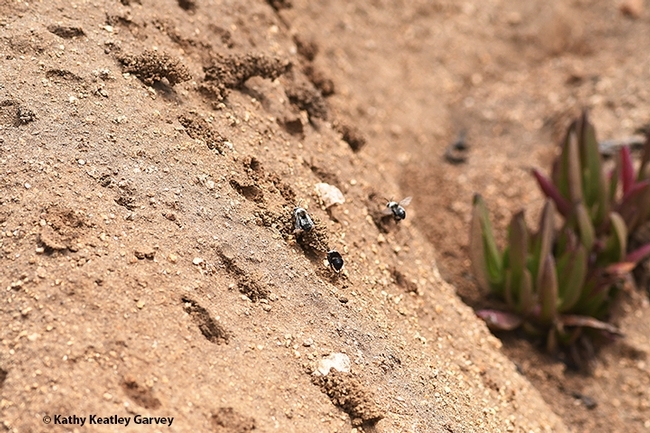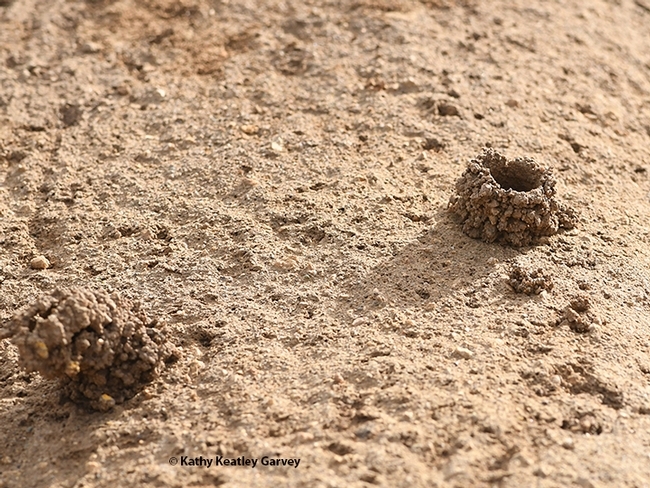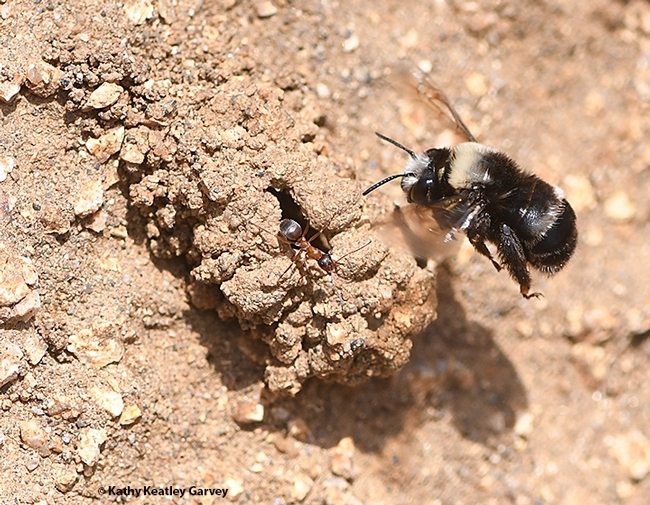Head to the Bodega Bay in Sonoma County and you'll see little kids building sandcastles on the beaches.
But head to Bodega Head in the spring and summer, and if you're lucky, you'll see female digger bees—bumble bee mimics—creating their own versions of sandcastles. These bees, Anthophora bomboides stanfordiana, build their nests in the sandy cliffs.
Look for the evidence: nest holes and tiny turrets.
If you missed it, be sure to access KQED's Deep Look video on “This Bee Builds Sandcastles at the Beach” by Gabriela Quirós and crew. It's educational, informative and entertaining. The photography is superb.
An excerpt from the Deep Look video: “It might seem peculiar to see bees at the beach. But the bumblebee-mimic digger bee (Anthophora bomboides stanfordiana) makes its home at beaches in Northern California and Oregon. Once they've mated, the females spend the spring digging their nests into sandy cliffs overlooking the Pacific Ocean.”
“They find a nearby source of water like a stream and slurp water into a pouch in their abdomen called a crop. They can make 80 daily trips back and forth from the stream to a cliff onto which they spray the water to soften it up. This allows them to dig a series of holes into which they lay their eggs.”
This digger bee is sometimes called the “Stanford bumble bee digger,” because the subspecies name, “stanfordiana,” refers to the Stanford University collection from 1904.
What do they mimic? The yellow-faced bumble bee, Bombus vosnesenskii, native to the West Coast of North America. But unlike the female bumble bees, female digger bees rarely sting and are not defensive.
The late Robbin Thorp (1933-2019), distinguished emeritus professor of entomology at UC Davis studied these bees. Current researchers include community ecologist Rachel Vannette, associate professor, UC Davis Department of Entomology and Nematology.
Thorp frequently pointed out that when most people think of bees, they think of honey bees. But there's a great diversity in bees, as he wrote in a paper, “Biodiversity and Pollination Biology of Bees in Coastal Nature Preserves,” that he and colleague Thomas Gordon presented at the Proceedings of the Symposium on Biodiversity of Northwestern California, held Oct. 28-30, 1991 in Santa Rosa. “The world bee fauna of bees (superfamily Apoidea) is estimated at 20,000 species,” they wrote. “Of these, about 10% are social, 75% are solitary, and 15 % are cuckoo parasites of other bees (Bohart, 1970).
“Bees are most diverse and abundant in arid warm temperate areas of the world, especially in the Mediterranean, California, and adjacent desert areas (Michener 1979),” they wrote. “With rare exceptions, bees rely on nectar and pollen as food resources: nectar primarily as energy for flight and other activities, pollen as nutrients for reproduction (ovarian and brood development). Most bees are generalists when foraging for nectar, restricted primarily by body or tongue size. Many bee species, however, exhibit host-specificity (oligolecty) in relation to pollen resources (Robertson, 1925; Linsley, 1958). Linsley and MacSwain (1958) define oligolecty as the collection of pollen from one or a few closely related plant species by all members of a bee species with use of alternative sources occurring only during stress periods when such pollen sources are locally (or temporarily) absent.”
“Bees are ‘keystone' species in most plant communities because of their importance as pollinators for the reproductive continuity of many flowering plants including rare and endangered species,” they related.
We've seen the digger bees at Bodega Bay foraging on wild radish and lupine in the spring and summer. And building sandcastles the ocean waves can't reach and people generally ignore.
Last week we saw a family checking out the holes in the sandy cliffs. “What are these?” they inquired.
“Digger bees, bumble-bee mimics,” I responded, mentioning the KQED “Deep Look” video.
They said they'd watch it.
We have a feeling they'll be back next year to watch the bees build their sandcastles.
Attached Images:

Digger bees, Anthophora bomboides stanfordiana, building their nests in the sand cliffs off Bodega Head. (Photo by Kathy Keatley Garvey)

These are the turrets, aka "sandcastles," that digger bees build in the sand cliffs off Bodega Head. (Photo by Kathy Keatley Garvey)

A digger bee, Anthophora bomboides stanfordiana, heading toward her nest at Bodega Head. (Photo by Kathy Keatley Garvey)